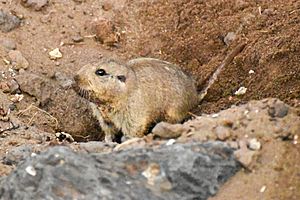Colburn's tuco-tuco facts for kids
Quick facts for kids Colburn's tuco-tuco |
|
|---|---|
 |
|
| Conservation status | |
| Scientific classification | |
| Genus: |
Ctenomys
|
| Species: |
colburni
|
Colburn's tuco-tuco (Ctenomys colburni) is a type of rodent that belongs to the family Ctenomyidae. It is only known to live in Argentina.
Contents
What is a Tuco-Tuco?
Tuco-tucos are small rodents that live underground. They are known for their strong claws, which they use for digging tunnels. The name "tuco-tuco" comes from the sound they make, which sounds like "tuc-tuc-tuc." This sound helps them communicate with each other in their underground homes.
Where Do They Live?
Colburn's tuco-tuco has only been found in Argentina. Other types of tuco-tucos live in different parts of South America, especially in grasslands and sandy areas. They prefer places where the soil is easy to dig.
Their Underground Homes
Tuco-tucos dig complex tunnel systems. These tunnels have different rooms for sleeping, storing food, and even a special area for their waste. They spend most of their lives underground, which helps protect them from predators and harsh weather.
What Do They Eat?
Tuco-tucos are herbivores, meaning they eat plants. Their diet mainly consists of roots, tubers, and stems that they find while digging. They also pull down plants from the surface into their tunnels to eat.
How They Find Food
With their excellent sense of smell, tuco-tucos can find roots and other plant parts underground. They use their strong teeth to chew through tough plant material.
Conservation Status
Colburn's tuco-tuco is listed as Data Deficient by the International Union for Conservation of Nature (IUCN). This means scientists do not have enough information about this species to know if it is endangered or not.
Why "Data Deficient"?
Being "Data Deficient" means that researchers have not studied Colburn's tuco-tuco enough. They need more surveys and research to understand how many of these animals exist and what threats they might face.
Protecting Tuco-Tucos
To help protect species like Colburn's tuco-tuco, scientists need to learn more about them. This includes finding out where they live, how many there are, and what might be harming their populations. This information helps conservation groups make plans to keep them safe.
See also


